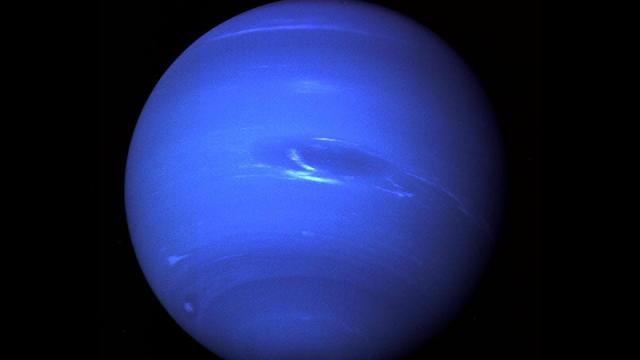Astronomers studying Neptune’s atmosphere found that the planet’s global temperature has dropped over a 17-year period, while its south pole has warmed considerably.
The temperature changes were captured in nearly 100 thermal-infrared images taken between 2003 and 2020 by several ground-based telescopes. Over that time period, the images reveal summer beginning in Neptune’s southern hemisphere and a global temperature drop of 8 degrees Celsius between 2003 and 2018. The team’s research is published today in The Planetary Science Journal.

“This change was unexpected,” said Michael Roman, an astronomer at the University of Leicester in England and lead author of the paper, in a European Southern Observatory release. “Since we have been observing Neptune during its early southern summer, we expected temperatures to be slowly growing warmer, not colder.”
Neptune is an ice giant 2.78 million miles from the Sun. A year on Neptune is to 165 Earth years, so it takes a while for the blue marble’s seasons to turn. Neptune’s 40-year seasons are the longest of any planet (Uranus’ seasons, the second-longest, are only about 20 years).
Summertime kicked off in Neptune’s south in 2005, and Roman’s team was able to observe the change in measurements taken by ground-based telescopes like Very Large Telescope in Chile and the Keck and Subaru telescopes in Hawai’i.
“Our data cover less than half of a Neptune season, so no one was expecting to see large and rapid changes,” co-author Glenn Orton, senior research scientist at Caltech’s Jet Propulsion Laboratory (JPL), said in the ESO release.
In visible light, Neptune looks as blue as ever (a result of how methane in the planet’s upper atmosphere reflects light). But seen in thermal-infrared light, Neptune’s south pole is noticeably bright, indicating a warmer temperature.
Array
The planet is generally cold, with average temperatures of about -364 degrees Fahrenheit, but in the last two years of the team’s observations, the polar temperatures increased from about -186 degrees Fahrenheit to -166 degrees Fahrenheit. Meanwhile, the areas around the planet’s equator became dimmer in the thermal-infrared imagery, meaning they cooled down.
The researchers aren’t sure what may cause the large variation between Neptune’s poles and its more central areas; weather patterns may have affected the observations, or changes in the planet’s stratospheric chemistry may have caused different temperatures. Upcoming ground-based telescopes — especially the Extremely Large Telescope — will be useful in looking at the second half of the Neptunian summer.
